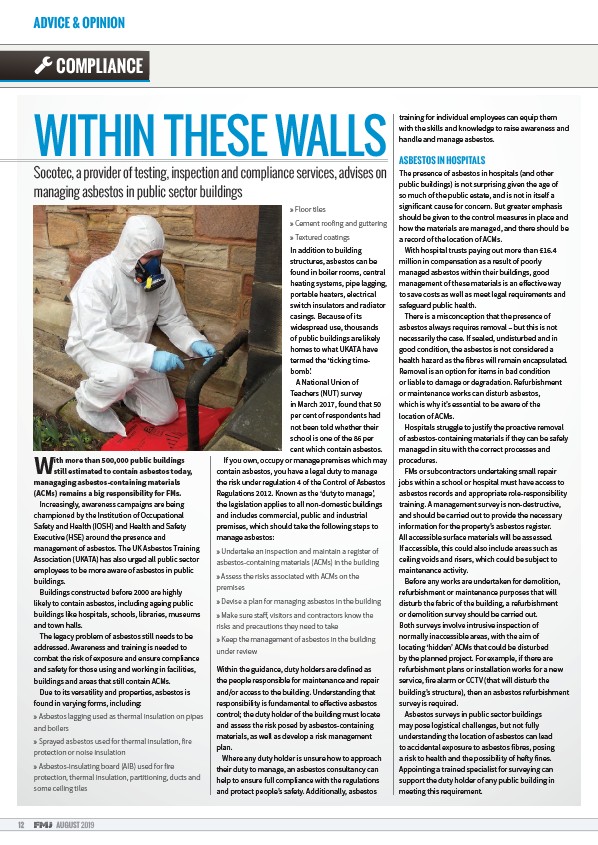
COMPLIANCE
WITHIN THESE WALLS
Socotec, a provider of testing, inspection and compliance services, advises on
managing asbestos in public sector buildings
With more than 500,000 public buildings
still estimated to contain asbestos today,
managaging asbestos-containing materials
(ACMs) remains a big responsibility for FMs.
Increasingly, awareness campaigns are being
championed by the Institution of Occupational
Safety and Health (IOSH) and Health and Safety
Executive (HSE) around the presence and
management of asbestos. The UK Asbestos Training
Association (UKATA) has also urged all public sector
employees to be more aware of asbestos in public
buildings.
Buildings constructed before 2000 are highly
likely to contain asbestos, including ageing public
buildings like hospitals, schools, libraries, museums
and town halls.
The legacy problem of asbestos still needs to be
addressed. Awareness and training is needed to
combat the risk of exposure and ensure compliance
and safety for those using and working in facilities,
buildings and areas that still contain ACMs.
Due to its versatility and properties, asbestos is
found in varying forms, including:
» Asbestos lagging used as thermal insulation on pipes
and boilers
» Sprayed asbestos used for thermal insulation, fire
protection or noise insulation
» Asbestos-insulating board (AIB) used for fire
protection, thermal insulation, partitioning, ducts and
some ceiling tiles
12 AUGUST 2019
» Floor tiles
» Cement roofing and guttering
» Textured coatings
In addition to building
structures, asbestos can be
found in boiler rooms, central
heating systems, pipe lagging,
portable heaters, electrical
switch insulators and radiator
casings. Because of its
widespread use, thousands
of public buildings are likely
homes to what UKATA have
termed the ‘ticking timebomb’.
A National Union of
Teachers (NUT) survey
in March 2017, found that 50
per cent of respondents had
not been told whether their
school is one of the 86 per
cent which contain asbestos.
If you own, occupy or manage premises which may
contain asbestos, you have a legal duty to manage
the risk under regulation 4 of the Control of Asbestos
Regulations 2012. Known as the ‘duty to manage’,
the legislation applies to all non-domestic buildings
and includes commercial, public and industrial
premises, which should take the following steps to
manage asbestos:
» Undertake an inspection and maintain a register of
asbestos-containing materials (ACMs) in the building
» Assess the risks associated with ACMs on the
premises
» Devise a plan for managing asbestos in the building
» Make sure sta , visitors and contractors know the
risks and precautions they need to take
» Keep the management of asbestos in the building
under review
Within the guidance, duty holders are defined as
the people responsible for maintenance and repair
and/or access to the building. Understanding that
responsibility is fundamental to e ective asbestos
control; the duty holder of the building must locate
and assess the risk posed by asbestos-containing
materials, as well as develop a risk management
plan.
Where any duty holder is unsure how to approach
their duty to manage, an asbestos consultancy can
help to ensure full compliance with the regulations
and protect people’s safety. Additionally, asbestos
training for individual employees can equip them
with the skills and knowledge to raise awareness and
handle and manage asbestos.
ASBESTOS IN HOSPITALS
The presence of asbestos in hospitals (and other
public buildings) is not surprising given the age of
so much of the public estate, and is not in itself a
significant cause for concern. But greater emphasis
should be given to the control measures in place and
how the materials are managed, and there should be
a record of the location of ACMs.
With hospital trusts paying out more than £16.4
million in compensation as a result of poorly
managed asbestos within their buildings, good
management of these materials is an e ective way
to save costs as well as meet legal requirements and
safeguard public health.
There is a misconception that the presence of
asbestos always requires removal – but this is not
necessarily the case. If sealed, undisturbed and in
good condition, the asbestos is not considered a
health hazard as the fibres will remain encapsulated.
Removal is an option for items in bad condition
or liable to damage or degradation. Refurbishment
or maintenance works can disturb asbestos,
which is why it’s essential to be aware of the
location of ACMs.
Hospitals struggle to justify the proactive removal
of asbestos-containing materials if they can be safely
managed in situ with the correct processes and
procedures.
FMs or subcontractors undertaking small repair
jobs within a school or hospital must have access to
asbestos records and appropriate role-responsibility
training. A management survey is non-destructive,
and should be carried out to provide the necessary
information for the property’s asbestos register.
All accessible surface materials will be assessed.
If accessible, this could also include areas such as
ceiling voids and risers, which could be subject to
maintenance activity.
Before any works are undertaken for demolition,
refurbishment or maintenance purposes that will
disturb the fabric of the building, a refurbishment
or demolition survey should be carried out.
Both surveys involve intrusive inspection of
normally inaccessible areas, with the aim of
locating ‘hidden’ ACMs that could be disturbed
by the planned project. For example, if there are
refurbishment plans or installation works for a new
service, fire alarm or CCTV (that will disturb the
building’s structure), then an asbestos refurbishment
survey is required.
Asbestos surveys in public sector buildings
may pose logistical challenges, but not fully
understanding the location of asbestos can lead
to accidental exposure to asbestos fibres, posing
a risk to health and the possibility of he‡ y fines.
Appointing a trained specialist for surveying can
support the duty holder of any public building in
meeting this requirement.
ADVICE & OPINION